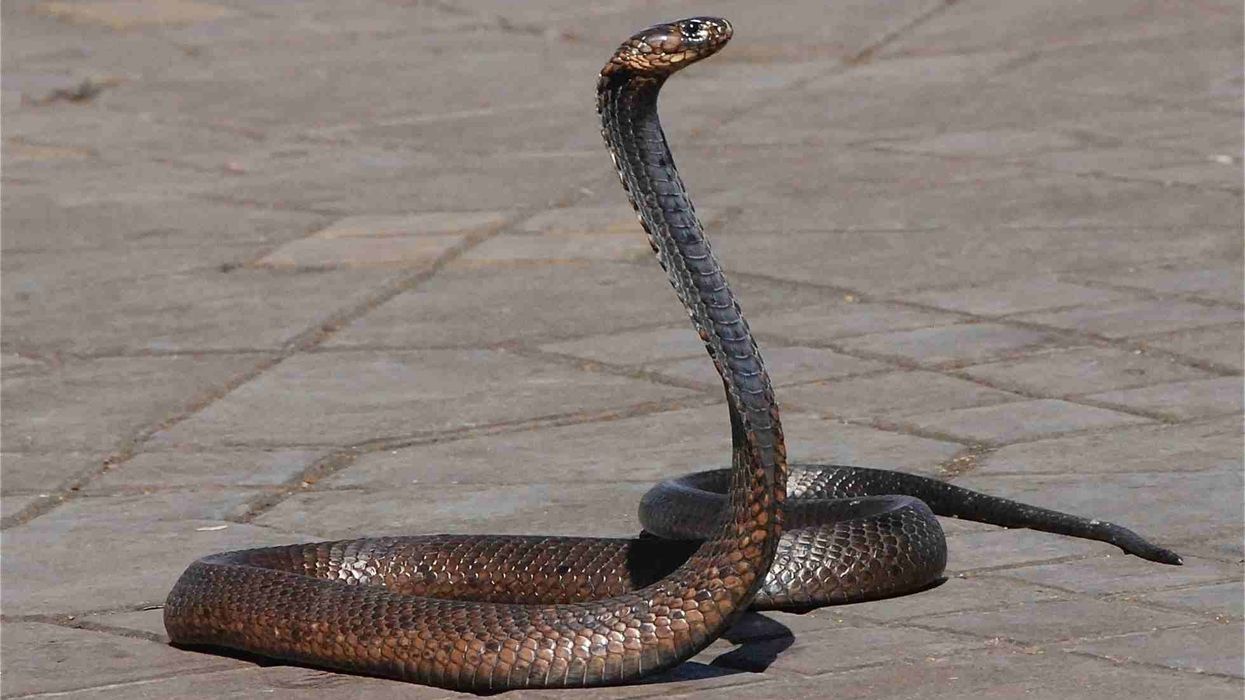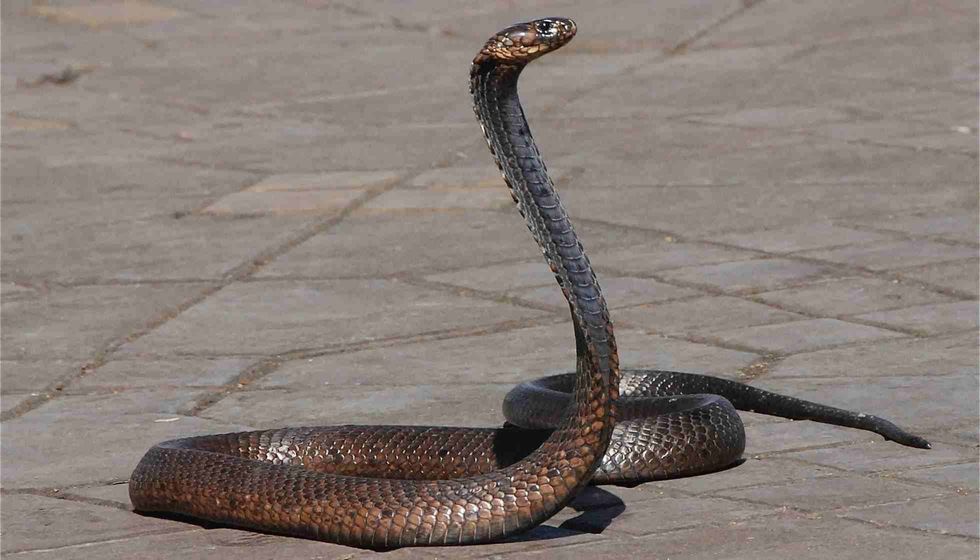Egyptian false cobras (Malpolon moilensis) are a species of snakes found mostly in the Middle Eastern countries and some parts of Africa. These reptiles grow up to a length of 59.05 in (1.5 m) and are usually a shy species of snakes.
This snake species is often mistaken with the false water cobras of South Africa.
False water cobras are quite similar to Egyptian false cobras in terms of behavior and venomous capabilities. False water cobras only differ in length as they are quite large and definitely bigger than the Egyptian false cobras.
These snake species are also known by the scientific name Rhagerhis moilensis. The Egyptian false cobra is generally known by various different names, such as hooded malpolon, moila snake, Talheh snake, and false cobra.
As the name actually suggests, these snakes are actually not cobras. Like the reptiles the false water cobra, Egyptian snakes are known to imitate the stance of the cobra snakes by spreading the head and hissing like the cobra.
Although the reptiles carry venom, their primary source of food is lizards and live mice. However, they are also seen feeding on smaller reptiles and birds.
There are a lot of false cobra snakes found all over the world apart from the false water cobra and the Egyptian false cobra. Almost all the other species of these snakes show familiar behavior and have similar food habits.
For more relatable content, check out these King Cobra facts and Cobra fun facts.
Egyptian False Cobra Interesting Facts
What type of animal is an Egyptian false cobra?
Egyptian false cobras are a species of snakes found in the Middle East and Africa.
What class of animal does an Egyptian false cobra belong to?
Egyptian false cobra (Malpolon moilensis) falls under the class of Reptiles in the kingdom of Animalia.
How many Egyptian false cobra are there in the world?
The population of these reptiles is not known. However, the numbers are steady currently and there is no immediate danger to the snakes.
Where does an Egyptian false cobra live?
The Egyptian false cobra is found throughout the Middle East and North Africa. These reptiles inhabit a range of countries like Algeria, Egypt, Iran, Iraq, Israel, Jordan, Kuwait, Lebanon, Libya, Mali, Morocco, Niger, Saudi Arabia, Sudan, Syria, Tunisia, Mauritania.
Their habitat ranges from Mauritania To Egypt And East Into Iran And Saudi Arabia. They are also seen sometimes in West Asia.
These snakes are not seen in the sand desert regions of the northern interior and Rub al-Khali of the Arabian Peninsula, as well as mountainous regions.
The false water cobra however does not encroach in their habitat and is found only in South American floodplains. These large reptiles are only found in places like Brazil, Paraguay, Bolivia, and Northern Argentina.
What is an Egyptian false cobra's habitat?
These snakes are said to be found only in areas up to a height of 4921.26 feet (1500 m). These reptiles known as Egyptian false cobras prefer habitats with stony semi-desert, desert margins, and dry open scrublands. They are found in the hot arid regions of their habitat.
The false water cobra is found in wet, tropical, and humid habitats, usually near streams or in river floodplains.
Who do Egyptian false cobra live with?
There is no information on the company these reptiles keep. However, snakes are known to be solitary and seen feeding alone.
How long does an Egyptian false cobra live?
With proper care in captivity, these reptiles are known to live up to the age of 12-18 years.
Other species of false cobras are also seen to live up to 20 years in captivity.
How do they reproduce?
The reproduction process of the Egyptian false cobra is not available. They are quite similar to the false water cobra of South America. So we will discuss the breeding process in these reptiles.
These snakes are active throughout the year and produce two clutches of eggs in a year. The reptiles lay 14-24 eggs in a season. The incubation period is about 60 days and hatchlings measure up to a length of 1.25 ft (38.1 cm).
Hatchlings of Egyptian false cobras resemble adults of leaf-nosed snakes, which usually do not possess the dark spot on the cheeks.
What is their conservation status?
The conservation status of the Egyptian false cobra (Malpolon moilensis) is categorized as 'Least Concern' by the IUCN Red List. There is no danger to the population of these reptiles currently and are found abundantly in their habitat.
Egyptian False Cobra Fun Facts
What do Egyptian false cobra look like?

Egyptian false cobra (Malpolon moilensis) is medium-sized in length and has a cylindrical body. They have a tapered tail which is usually longer in length than other species. The head is elongated and the snout is projected outwards and is pointed.
The reptiles have smooth dorsal scales. The head is shield-shaped when looked at from above. They have large distinct red pupils that are generally round-shaped.
The pattern and contour of the scales give the reptiles a beaded look. The body looks muscular and thick. The tail is almost 20% of the whole length of the snake.
The snake is sand or straw-colored with grey-brown blocks dark in color. It gives a chequered look. Running the length of the snake are alternating dark grey-brown spots on the flanks.
The ventral surface is cream or white-colored. A dark brown or black spot can be seen on the head, along the cheeks. This dark patch is smaller in some species.
When this snake is threatened, they are known to imitate a cobra's stance by turning their head into a hood and hiss like a typical cobra. This behavior is similar to the false water cobra as they also flatten their neck to appear larger and intimidating.
They also look quite the same as the Egyptian false cobra as they also have dark spots along the length of their bodies.
How cute are they?
Snakes are not everyone's favorites. However, with proper training, they can become quite friendly and their daily behaviors can seem quite cute.
How do they communicate?
They usually communicate by hissing and pheromones.
How big is a Egyptian false cobra ?
The size of the adults of the Egyptian false cobra (Malpolon moilensis) can go up to 74.8 in (1.9 m). However, the average length of this species ranges from 31.49-55.11 in (0.8-1.4 m).
How fast can a Egyptian false cobra move?
The speed is not known. However, they are known to be quite agile and quick. They move pretty fast when threatened.
How much does a Egyptian false cobra weigh?
The weight of the species is not recorded. King Cobras typically weighs around 13 lb (5.9 kg).
What are the male and female names of the species?
The males and females of the Egyptian false cobras are not given different names.
What would you call a baby Egyptian false cobra ?
A baby cobra is called a hatchling.
What do they eat?
The Egyptian false cobra, similar to the false water cobras, has been seen feeding on different types of rodents, mice, lizards, and fledging birds. Their feeding also includes food like gerbils, small mammals, and cockroaches.
While in captivity, they are also seen feeding on live or dead mice and frozen foods (Pinkie mice). They are also seen to swallow their prey live sometimes.
All false cobras and even some species of typical cobras are known for feeding on different mice and lizards and are their favorite kind of prey.
Are they poisonous?
Egyptian false cobra (Malpolon moilensis) is poisonous but the extent of danger in their venom is not known. They are pretty fast and agile attackers and can kill their prey in minutes. The poison might not be deadly but can cause pain, swelling, or other complications.
Would they make a good pet?
Snakes are not the first choice for pets. But, these false cobras make a good and docile pet. They are fairly hardy, but shouldn't be handled much. It's easy to feed them also as they prefer dead or alive mice.
Did you know...
Egyptian false cobra (Malpolon moilensis) is not endemic to one part. They are found in Africa and the Middle East.
What is the most poisonous snake in Egypt?
There are many venomous snakes found in the deserts of Egypt. The Egyptian cobra can be considered the most poisonous snake found in Egypt as its venom contains both neurotoxins and cytotoxins. Egyptian mythology says that Cleopatra committed suicide by getting bitten by this snake intentionally.
There are other venomous snakes found in Egypt like black desert cobra, red spitting Cobra, Sahara sand viper, and Saharan horned viper.
What is the most venomous snake in the world?
The Inland Taipan is considered to be the most ven0mous snake in the world. They are native to Southeastern Australia. The venom of this snake works quite quickly and a single bite from the Inland Taipan can kill you in 30-45 minutes if kept untreated. Their venom is deadly enough to kill an elephant in a few hours!
Learn more about some other reptiles from our crocodiles facts or blue tongue skink facts pages.
You can even occupy yourself at home by coloring in one of our Snake coloring pages.









